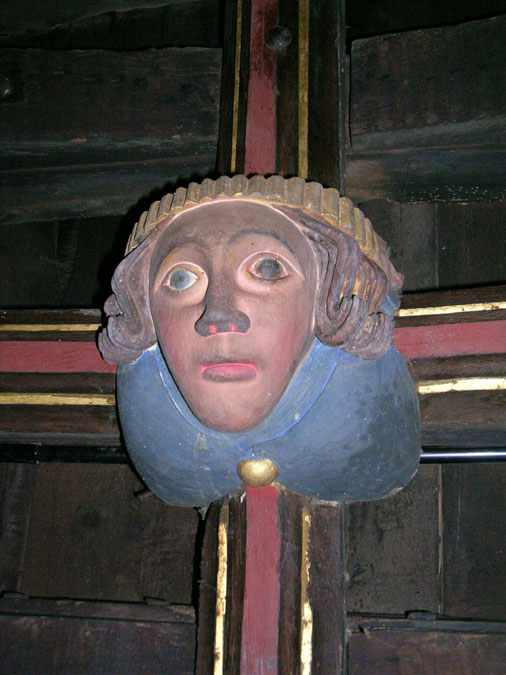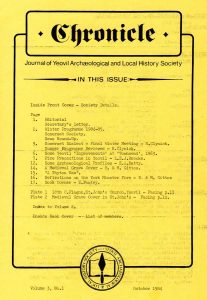Review of Final Winter Meeting and Summer Programme
SOMERSET DIALECT – Final Winter Meeting
Author: Russ Clynick
On 6th April Dr.J,B.Smith of Bath University gave the final talk of the winter session entitled “Somerset Dialect”. He described how from its beginnings the English Language had had differing regional usage and pronunciation. This was a particular feature of speech in the south west of England. Over a long periods West Country talk was considered vulgar and barbarous by the more enlightened inhabitants of the home counties and the upper classes in general. Dr.Smith was careful to distinguish between “dialect” which is concerned with the use of unusual words and deviant grammar and “accent” which refers to different ways in which the same word is pronounced. He was warmly thanked by Miss Isobel Rendell.
SUMMER PROGRAMME REVIEWED
Author: Russ Clynick
ILCHESTER: A “walkabout” in Ilchester on 27th April was the first of out-door excursions and it was led by Roy Scutchings of the Ilchester Archaeological Society. He gave a detailed and interesting account of the long history of this very important settlement, from the Roman era through Saxon and Medieval times to the more recent developments in the 17th and 18th centuries. Members were conducted on a tour of many of the sites he had described, most, alas, now buried or built upon. However the town hall and remnants of the Gaol were notable amongst the extant buildings. Patterns of a medieval field system to the south of the town were richly evident in the evening light from the vantage point afforded by the foot bridge over the A37.
The walk ended at the church of St.Mary Major where the party was greeted by the vicar the Rev,Perry who gave a fluent account of the ecclesiastical history of Illchester and the seven churches it possessed in medieval times (now reduced to two). He described the important features of his Parish Church and encouraged his guests to explore the building.
Bill Chapman, thanked both our hosts for making the event such an unqualified success.
EAST SOMERSET RAILWAY: The weather was decidedly inclement for the Society’s coach visit to the East Somerset Railway at Cranmore near Shepton Mallet on 20th May.
The ‘Railway is a private undertaking, where seemingly worn-out steam locomotives and rolling stock are restored to working order and put to limited use for public enjoyment. The operation is under the direction of its founder David Shepherd, the famous wild-life artist and conservationist. The work is done by a band of dedicated volunteers with some expert direction and is carried out at week-ends and holidays.
Cranmore is very much the “Halt” of former times with all the usual features and on entering the station you could be forgiven sor expecting to see the express roaring through at anytime! Alas, there is currently only a limited service running from Cranmore to Merryfield Lane and back – a distance of approximately one mile in each direction. This brief nostalgic journey was the highlight of the visit. Amongt the notable exhibits were the tank engine “Bluebell” in temporary storage from the Bluebell Railway in Sussex, the impressive heavy locomotive Black Prince and the engine shed in which engines are housed. The latter is remarkable in being a modern re-creation of a Great Western loco shed.
The Railway celebrates its tenth anniversary this year and all those who have participated in its formation and progress must be justifiably proud of the project.
SHERBORNE WEST MILL: On Friday 8th June, a sizeable party of members Met at Sherborne West Mill. It is being restored by boys from Sherborne School, under the supervision of one of the Masters, Mr.H.Ridgeway, who kindly showed us around the mill and described the work being done. The mill was probably part of the Sherborne Abbey complex in medieval times. It is an ancient site, probably 15th C., but the buildings now being restored are thought to date from the 16th C. The water-wheel, which may have been built at Beaminster, dates from the 19th C. Breadmaking was carried out in the adjacent Bakehouse, where ovens are now being replaced. The mill was working until the middle of this century, but had sadly deteriorated before the current restoration commenced a labour of love, which the boys have taken on voluntarily. The miller’s cottage is also being restored and when the whole project is completed. it is hoped to add a small museum. Incidentally, the water course which operated the wheel comes down from the lake at Sherborne Castle. Members were given the opportunity of inspecting both floors of the mill, including the wooden-toothed gear wheels which made up the drive mechanism. Our Chairman warmly thanked Mr.Ridgeway for his welcome and for providing us with an entertaining and instructive venture into the realm of industrial archaeology.
WELLS CATHEDRAL: Following the Edgar Silcox memorial lecture on Wells Cathedral given by the Very Reverend Patrick Mitchell, Dean of Wells in 1983, the Society accepted his kind invitation and duly visited the Cathedral on 27rd June 1984. The party assembled before the West Front where the Dean pointed out many interesting details. He then took the party on a conducted tour of the outside of the Cathedral passing through the cloisters to the Camery where the recent excavations of Bishop Stillington’s Chapel took place. The Dean described what had been found and indicated the brevity of the Chapel’s existence due to its demolition at the Reformation. Beneath the 15th C, Chapel the ground plan of the east lend of the Saxon Cathedral had been revealed proving that the Gothic Cathedral had been built alongside the Saxon building rather than on top of it. The Dean finally led the party into the Cathedral via the North Porch which has some particularly fine sculpture and is often overlooked by visitors. The tour ended in the Chapter House where the Dean was warmly thanked for his kindness and for giving up so much of his time on our behalf.
MIDELNEY MANOR: Early in July, an evening visit was made to the medieval manor house of Midelney, the “middle island’ between Muchelney and Thorney. It was originally a manor of the Abbots of Muchelney, of whom the Trevilian family were tenants. The present house was built by two brothers during Elizabethan times. The occupier, Major R.Cely-Trevilian received us and in his welcome, gave a detailed account of the Manor’s history, the principal changes in the family’s fortunes and the alterations to the structure of the house. The party was then divided into two groups, because the manor was not large enough to accommodate the whole party. While one group was conducted around the house the other explored the extensive gardens and parkland. The house contain’s a varied collection of period furniture, paintings, china and family treasures. Later we were entertained to a buffet supper in the dining room, which rounded off an enjoyable evening visit. Our Chairman, Bill Chapman, expressed our thanks and appreciation to our Host and Hostess.
DORSET COUNTY MUSEUM: On 27th July, members of the Society paid a visit to the Dorset County Museum and were received by the Curator, Mr.R.N.R.Peers. In recent years, there have been great changes to the Museum, and these were described by Mr.Peers. He outlined the history of the Museum and explained the arrangement of the different collections in their respective galleries. These are the Thomas Hardy and “Dorset Worthies” Hall, the Geology and the Natural History Galleries, the Bygones collection and the Archaeology section. At the rear of the building, there has been a magnificent extension on the site of what used to be the Coach House and Stables of the George Inn, and it is here that the Skyrme Collection of bygones is displayed. The Curator pointed out that the Museum, which was founded in 1846 belongs to the Dorset Natural History and Archaeological Society, not Dorset County Council, but is helped financially by a grant from the Council. During the past 18 years, over £200,000 has been raised by members to pay for the erection of a new gallery and other alterations. Our Chairman expressed our appreciation and thanks to Mr.Peers for giving up an evening to make our visit so informative and enjoyable.
CHARD MUSEUM AND WALKABOUT: A visit to Chard Museum and a walkabout in the town on September lst was much enjoyed by a group of members. We were met by Mr.Brian Knight, Chairman of Chard Local History Society, Mrs.Edwards the Museum Custodian, and Mr.Hoskins, a local historian “who knows, Chard like the back of his hand”, and who later led the town walk. Mr.Knight gave a detailed account of the museum’s origins and subsequent development, to the present time. The contents of the museum are many and varied — industrial, commercial and domestic, ranging from tiny shoes of a bygone age and artificial limbs, to a huge cider press and a model of Stringfellow’s monoplane of 1848. Following a welcome cup of tea, by kindness of our hosts, we set out on the walkabout. Mr.Hoskins pointed out the 16th C. Grammar School, the Stuart Court House, with its great hall and original heavy timbered passage entrance. We saw too the site of a 300 year old corn mill, a row of shops, behind whose facade hides a 16th C. structure, and a factory set up by Mr.Boden, whose enterprise included a welfare scheme for his workforce, comparable with those of the Frys and Cadburys of our own time. In the absence of the Chairman, our Secretary, John Moon, expressed our thanks and appreciation to Mr.Knight, Mrs.Edwards and Mr.Hoskins.
N.B. During the visit it was noted that one of the cases contained a shield from monumental brass, which was not identified. A subsequent search through Connor’s “Monumental Brasses of Somerset” revealed that the shield bearing the arms of Bures of Somerset was formerly preserved at Taunton Castle Museum. It came originally from the destroyed church at Knowle St.Giles (near Chard) and was part of a memorial with inscription plate to John Burre (or Buren} who died. in 1584. This information was duly passed to Mr.Knight. (Russ Clynick)
HALSTOCK VILLA The long sunny summer ended at Halstock on 8th September. For much of the 2 hour Society visit the rain fell heavily. None of this could be blamed on Ron Lucas who is in charge of the excavation and who guided the undaunted party round the site during a brief dry interlude. This year’s digging has been more productive than the previous year and it was perhaps appropriate that the main features to be seen comprised an elaborate water system draining through several stone—lined tanks into a large pond. The whole complex lies within the courtyard of the villa close to the corridor on the north side. Mr.Lucas invited sugestions as to the purpose of the water system and said that the most likely explanation was a type of Roman fish farming. A large grooved piece of rough cut ham stone was found in the pond which had probably come from the inlet channel. After many years of digging at Halstock Mr.Lucas has decided that next season will be the last, so that, the results can be written up and published. Sadly this will mean the end of what has become an enjoyable annual pilgrimage by the Society, but we wish Mr.Lucas well in his endeavours to publish the full account of one of England’s most thoroughly excavated villa complexes. (B.C.Gittos)

